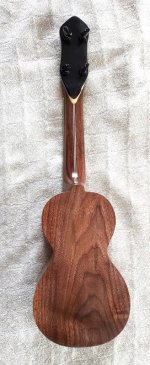humblej
Active member
- Joined
- Feb 14, 2022
- Messages
- 39
- Reaction score
- 28
My first soprano ukulele build did not give me the sound I had wanted and I didn't really care for my choice of wood as well as a few design details of the plans, so removed the tuners and usable hardware and threw the rest of it away. I started over from scratch and with added experience and what I have been learning here, ended up with more of the sound I was after. In comparison to the first build, this one sounds a bit harp like rather than tinny. Walnut body, neck, and fretboard, quilted maple for the soundboard, shellac finish, abalone dots, GHS black nylon strings. The maple had a defect in it that I couldn't see until I ran it thru the thickness sander a few times. Since it was not a split I thought it would look OK after filling with super glue, but that just made it look worse. As this build was another experiment I went ahead and used it.
Attachments
Last edited:



